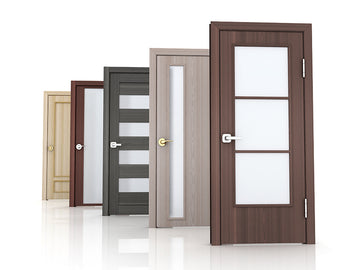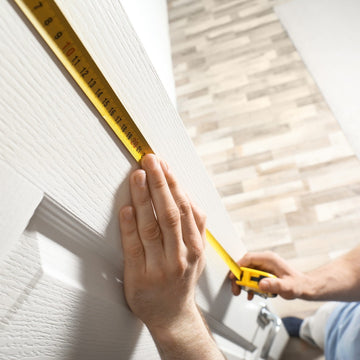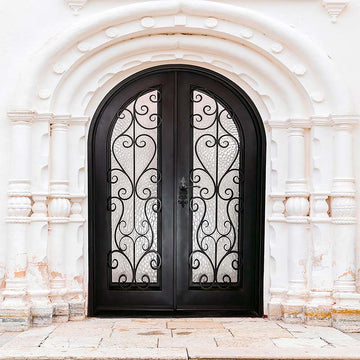
Standard Exterior Door Sizes: A Comprehensive Guide With Size Chart
The door to your home serves as a gateway and plays a significant role in security, aesthetics, energy efficiency, and compliance with building codes. Our guide includes a chart with standard door heights and widths for quick reference and highlights the differences between door slabs and pre-hung doors to help you measure your doorways accurately.
Why Knowing Standard Exterior Door Sizes Is Important
Knowing standard exterior door sizes is essential for homeowners, property developers, builders, and designers. A properly sized door operates smoothly and withstands daily use without unnecessary wear and tear. However, an ill-fitting door can lead to difficulties in opening or closing, increasing the risk of damage or injury.
Eliminating gaps prevents drafts, moisture, or pests from entering, enhancing your home's energy efficiency and safety. Gaps around the door frame can let conditioned air escape and outdoor air seep in, leading to higher energy bills and reduced comfort.
A door that complements your home's architectural style and proportions enhances curb appeal. Sticking to standard sizes helps you comply with building codes, which often specify door dimensions for safety and accessibility reasons.
When selecting a door, it's essential to consider the difference between slab and pre-hung door sizes:
- Door slab: The door itself, without hinges, frame, or bore holes for hardware
- Pre-hung door: The door slab is mounted on hinges within its own frame, ready for installation
Accounting for both measurements is the best way to ensure your door fits perfectly.
Standard Exterior Door Heights
Exterior doors come in various heights to suit different architectural styles and functional needs. Common exterior heights include:
- 80 inches (6 feet 8 inches): This is the most common standard height for residential exterior doors, fits well with common ceiling heights, and is widely available in an array of styles.
- 96 inches (8 feet): Taller doors create impressive entrances and allow more natural light through additional glass panels.
However, opting for taller or custom-sized exterior doors might be beneficial in certain scenarios:
- Modern or contemporary homes with high ceilings typically benefit from taller doors to maintain proportional aesthetics.
- A taller door makes a striking statement, enhancing the visual impact of your home's entrance.
- Custom-sized doors offer flexibility to accommodate unique design elements or differentiate your home.
Remember to factor in slab and pre-hung sizes when considering taller doors, as the frame
adds to the overall height and width.
Tall vs. Standard Height: Choosing the Right Fit
Choosing taller exterior doors over regular heights enhances curb appeal by creating a grand entrance that elevates your home's aesthetic. Mediterranean and Spanish Colonial homes, common in California and Florida, benefit from taller doors featuring arched designs and intricate ironwork, adding authenticity and elegance.
In the Southern United States, 19th-century and Greek revival homes often incorporate taller doors to match their towering columns and expansive porches, achieving architectural cohesion. Additionally, Victorian and Georgian homes in the Northeast can utilize taller doors with elaborate transoms and sidelights, enriching the facade with classic charm and allowing more natural light into the interior.
Practical Differences Between Slab and Pre-Hung Sizes
Some differences between slab and pre-hung sizes include:
- Taller pre-hung doors require precise measurements and may necessitate adjustments to the existing doorway.
- Custom or taller doors can be more expensive due to their nonstandard size and additional materials.
- Larger doors are heavier, requiring sturdy hardware and possibly professional installation.
Standard Exterior Door Widths
Taking into account the width of your exterior door is vital for accessibility, furniture movement, and the overall look of your home's entrance:
- 32 inches: Often used for back or side doors where space is limited
- 36 inches: Standard for front doors, offering ample space for moving large items and better accessibility
- 42 inches or more: Make a bold statement and are ideal for grand entrances or accommodating double doors
The ideal widths for accessibility and aesthetics are:
- Doors that are 36 inches wide or more are ideal for accommodating wheelchairs and other mobility aids.
- Wider doors enhance the visual impact of your entrance, adding to your home's curb appeal.
- Extra width simplifies moving furniture, appliances, and other large items in and out of your home.
Size Chart for Standard Exterior Door Sizes
Below is a size chart for quick reference:
|
Door Type |
Standard Heights (inches) |
Standard Widths (inches) |
|
|
|
Door Slab |
80, 96 |
32, 36, 42 |
|
|
|
Pre-Hung Door |
81.5, 97.5 |
33.5, 37.5, 43.5 |
|
|
Pre-hung doors include the frame, which adds approximately 1.5 inches to the height and width.
How to measure your door opening:
-
Start by measuring the width and height of your existing door slab and the rough opening.
- Width: Measure across the top, middle, and bottom of the opening; use the smallest measurement.
- Height: Measure from the floor to the top of the opening on both sides; use the smallest measurement.
- Depth: Measure the thickness of the wall to ensure the door frame fits properly.
Choosing the Right Exterior Door Size for Your Home
Selecting the correct exterior door size impacts your home's security, comfort, functionality, and curb appeal.
Ready to transform your home's entrance with the perfect exterior door? Explore AAA Doors' collection of exterior doors, or reach out to us for personalized guidance. Our team is here to help you make the best choice for your needs, enhancing your home's beauty and functionality.











